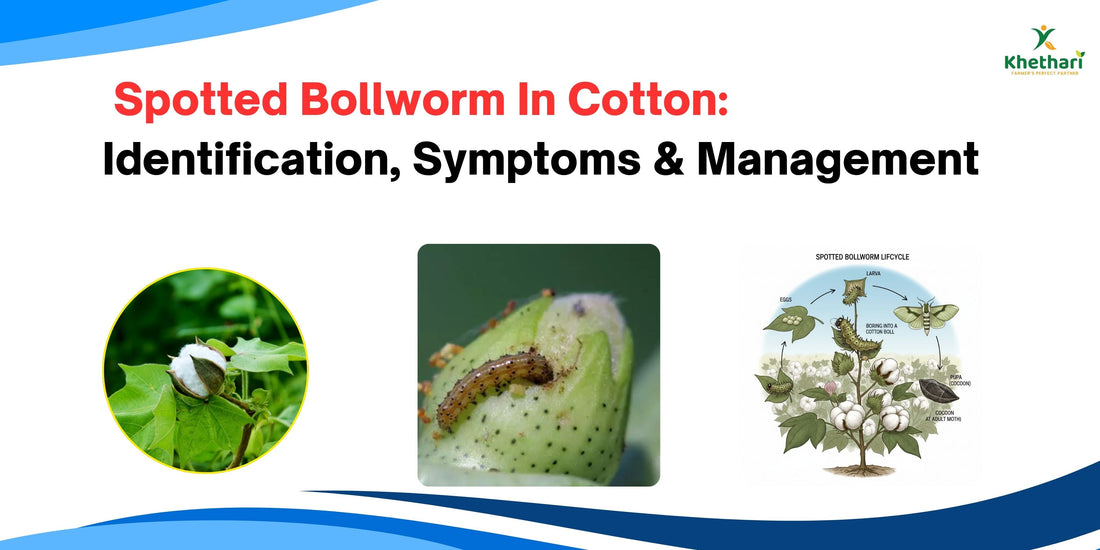
Spotted Bollworm In Cotton: Identification, Symptoms & Management
1. Pest Overview
Scientific Classification:
- Kingdom: Animalia
- Phylum: Arthropoda
- Class: Insecta
- Order: Lepidoptera
- Family: Noctuidae
- Genus & Species: Earias vittella (Fabricius, 1794)
Common Names:
- Spotted Bollworm
- Spotted Cotton Bollworm
- Small Cotton Bollworm (in some regions)
Significance:
The Spotted Bollworm is a major lepidopteran pest of cotton, causing both direct and indirect crop losses. Larval feeding damages flower buds, tender leaves, and young bolls, leading to:
- Premature boll shedding
- Reduced fiber quality
- Significant yield losses (up to 40–50% in severe infestations)
Economic impact is particularly high in tropical and subtropical cotton-growing regions, where multiple generations occur annually.
2. Morphology & Identification
Eggs:
- Shape: Spherical or slightly oval
- Size: 0.5–0.6 mm diameter
- Color: Initially pale yellowish, turning darker before hatching
- Laid: Singly or in small clusters on undersides of leaves, buds, or young bolls
Larvae (Caterpillars):
- Length: 12–20 mm at maturity
- Body Color: Pale green to yellowish-green
- Distinctive Feature: Dark spots along the dorsal surface, which give the pest its name
- Head: Light brown or slightly darker than body
- Behavior: Bores into buds and bolls; feeds internally
- Feeding Pattern: Skeletonized leaves, bored buds, frass accumulation inside bolls
Pupae:
- Color: Light brown to reddish-brown
- Location: Folded leaves, soil near plant base, or inside damaged bolls
- Duration: 7–10 days under favorable conditions
Adult Moths:
- Wingspan: 18–22 mm
- Color: Pale yellowish-green to light brown
- Distinctive Marks: Dark spots on forewings
- Behavior: Nocturnal; lay eggs mainly during evening and night
Field Identification Tips:
- Check flower buds and bolls for tiny holes or frass deposits.
- Look for chewed leaves with irregular “windowpane” patterns.
- Frass or excreta at the base of bolls indicates larval activity.
3. Life Cycle & Reproduction
|
Stage |
Duration (Days) |
Notes |
|---|---|---|
|
Egg |
3–5 |
Laid on leaves or buds; hatches in 3–5 days |
|
Larva |
10–15 |
Multiple instars; feeds inside buds/bolls |
|
Pupa |
7–10 |
Pupates in folded leaves or soil |
|
Adult Moth |
7–10 |
Lays 100–200 eggs per female |
- Total Life Cycle: 25–35 days (depends on temperature and humidity)
- Generations: 4–6 per year in tropical climates
- Reproductive Potential: High fecundity allows rapid population buildup
4. Host Range & Infestation Sites
Primary Host: Cotton (Gossypium spp.)
Secondary Hosts:
- Hibiscus
- Okra
- Other Malvaceae family plants
Affected Plant Parts:
- Flower buds: Hollowed or partially eaten
- Young bolls: Bored internally; may drop prematurely
- Tender leaves: Skeletonized feeding or “windowpaning”
Larvae are internal feeders, making early detection critical to prevent yield loss.
5. Symptoms & Field Damage
Leaf Symptoms:
- Skeletonized leaves or irregular “windowpane” patterns
- Curling or distortion in severe feeding areas
Flower Buds & Bolls:
- Boreholes on buds and bolls
- Frass accumulation inside bolls
- Premature shedding of flower buds and small bolls
Yield Losses:
- Reduction in harvestable bolls
- Lower cotton fiber quality
- Secondary infection by fungi due to damaged tissue
Secondary Effects:
- Increased susceptibility to boll rot and other diseases
- Weak plant growth in severe infestations
6. Monitoring & Scouting
Scouting Frequency:
- Every 7–10 days, especially during flowering and boll formation stages
Sampling Method:
- Inspect 5–10 plants per acre from different locations
- Focus on buds, bolls, and tender leaves
Threshold for Action:
- Intervention recommended when 5–10% of buds or bolls show infestation
Monitoring Tools:
- Pheromone traps for adult moth detection
- Observation of larvae, frass, and damage symptoms
7. Integrated Pest Management (IPM) Practices
Cultural Control:
- Remove and destroy crop residues after harvest
- Maintain proper spacing and weed management
- Rotate cotton with non-host crops to reduce pest carryover
- Avoid excessive nitrogen fertilization, which favors pest proliferation
Biological Control:
- Encourage egg parasitoids like Trichogramma spp.
- Predators such as lady beetles, lacewings, and spiders
- Use Bacillus thuringiensis (Bt) sprays for larval control
Chemical Control:
- Spray based on scouting thresholds; avoid blanket applications
- Rotate chemical groups to prevent resistance
- Target sprays in evening or night when larvae are active
- Recommended groups: pyrethroids, spinosyns, or selective insecticides per local guidelines
Monitoring & Agri-input Solutions:
- Pheromone traps to predict moth emergence
- Sticky traps for adult population tracking
- Scouting-based pesticide applications for cost-effective management
8. Farmer Advisory & Practical Tips
- Early Signs: Frass on bolls, bored buds, windowpaned leaves
- Control Measures: Combine cultural, biological, and chemical methods
- Spray Safety: Use recommended doses and protective gear
- Field Hygiene: Remove alternate host plants nearby
- Cost-effectiveness: Monitor pest population and spray only when thresholds are exceeded
9. Conclusion
Spotted Bollworm (Earias vittella) is a persistent and damaging pest of cotton. Effective management relies on:
- Early detection through careful scouting
- Integrated strategies combining cultural, biological, and chemical control
- Judicious pesticide use to prevent resistance
- Promoting sustainable practices that are both economically viable and environmentally friendly
By adopting these strategies, cotton farmers can protect yield, maintain fiber quality, and reduce economic losses while minimizing unnecessary pesticide use.



